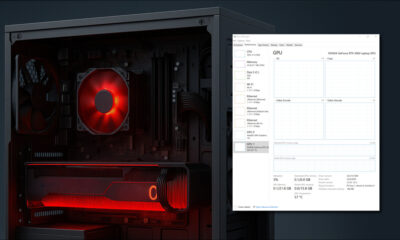Artificial Intelligence
TensorRT-LLM: A Comprehensive Guide to Optimizing Large Language Model Inference for Maximum Performance

As the demand for large language models (LLMs) continues to rise, ensuring fast, efficient, and scalable inference has become more crucial than ever. NVIDIA's TensorRT-LLM steps in to address this challenge by providing a set of powerful tools and optimizations specifically designed for LLM inference. TensorRT-LLM offers an impressive array of performance improvements, such as quantization, kernel fusion, in-flight batching, and multi-GPU support. These advancements make it possible to achieve inference speeds up to 8x faster than traditional CPU-based methods, transforming the way we deploy LLMs in production.
This comprehensive guide will explore all aspects of TensorRT-LLM, from its architecture and key features to practical examples for deploying models. Whether you’re an AI engineer, software developer, or researcher, this guide will give you the knowledge to leverage TensorRT-LLM for optimizing LLM inference on NVIDIA GPUs.
Speeding Up LLM Inference with TensorRT-LLM
TensorRT-LLM delivers dramatic improvements in LLM inference performance. According to NVIDIA’s tests, applications based on TensorRT show up to 8x faster inference speeds compared to CPU-only platforms. This is a crucial advancement in real-time applications such as chatbots, recommendation systems, and autonomous systems that require quick responses.
How It Works
TensorRT-LLM speeds up inference by optimizing neural networks during deployment using techniques like:
- Quantization: Reduces the precision of weights and activations, shrinking model size and improving inference speed.
- Layer and Tensor Fusion: Merges operations like activation functions and matrix multiplications into a single operation.
- Kernel Tuning: Selects optimal CUDA kernels for GPU computation, reducing execution time.
These optimizations ensure that your LLM models perform efficiently across a wide range of deployment platforms—from hyperscale data centers to embedded systems.
Optimizing Inference Performance with TensorRT
Built on NVIDIA’s CUDA parallel programming model, TensorRT provides highly specialized optimizations for inference on NVIDIA GPUs. By streamlining processes like quantization, kernel tuning, and fusion of tensor operations, TensorRT ensures that LLMs can run with minimal latency.
Some of the most effective techniques include:
- Quantization: This reduces the numerical precision of model parameters while maintaining high accuracy, effectively speeding up inference.
- Tensor Fusion: By fusing multiple operations into a single CUDA kernel, TensorRT minimizes memory overhead and increases throughput.
- Kernel Auto-tuning: TensorRT automatically selects the best kernel for each operation, optimizing inference for a given GPU.
These techniques allow TensorRT-LLM to optimize inference performance for deep learning tasks such as natural language processing, recommendation engines, and real-time video analytics.
Accelerating AI Workloads with TensorRT
TensorRT accelerates deep learning workloads by incorporating precision optimizations such as INT8 and FP16. These reduced-precision formats allow for significantly faster inference while maintaining accuracy. This is particularly valuable in real-time applications where low latency is a critical requirement.
INT8 and FP16 optimizations are particularly effective in:
- Video Streaming: AI-based video processing tasks, like object detection, benefit from these optimizations by reducing the time taken to process frames.
- Recommendation Systems: By accelerating inference for models that process large amounts of user data, TensorRT enables real-time personalization at scale.
- Natural Language Processing (NLP): TensorRT improves the speed of NLP tasks like text generation, translation, and summarization, making them suitable for real-time applications.
Deploy, Run, and Scale with NVIDIA Triton
Once your model has been optimized with TensorRT-LLM, you can easily deploy, run, and scale it using NVIDIA Triton Inference Server. Triton is an open-source software that supports dynamic batching, model ensembles, and high throughput. It provides a flexible environment for managing AI models at scale.
Some of the key features include:
- Concurrent Model Execution: Run multiple models simultaneously, maximizing GPU utilization.
- Dynamic Batching: Combines multiple inference requests into one batch, reducing latency and increasing throughput.
- Streaming Audio/Video Inputs: Supports input streams in real-time applications, such as live video analytics or speech-to-text services.
This makes Triton a valuable tool for deploying TensorRT-LLM optimized models in production environments, ensuring high scalability and efficiency.
Core Features of TensorRT-LLM for LLM Inference
Open Source Python API
TensorRT-LLM provides a highly modular and open-source Python API, simplifying the process of defining, optimizing, and executing LLMs. The API enables developers to create custom LLMs or modify pre-built ones to suit their needs, without requiring in-depth knowledge of CUDA or deep learning frameworks.
In-Flight Batching and Paged Attention
One of the standout features of TensorRT-LLM is In-Flight Batching, which optimizes text generation by processing multiple requests concurrently. This feature minimizes waiting time and improves GPU utilization by dynamically batching sequences.
Additionally, Paged Attention ensures that memory usage remains low even when processing long input sequences. Instead of allocating contiguous memory for all tokens, paged attention breaks memory into “pages” that can be reused dynamically, preventing memory fragmentation and improving efficiency.
Multi-GPU and Multi-Node Inference
For larger models or more complex workloads, TensorRT-LLM supports multi-GPU and multi-node inference. This capability allows for the distribution of model computations across several GPUs or nodes, improving throughput and reducing overall inference time.
FP8 Support
With the advent of FP8 (8-bit floating point), TensorRT-LLM leverages NVIDIA’s H100 GPUs to convert model weights into this format for optimized inference. FP8 enables reduced memory consumption and faster computation, especially useful in large-scale deployments.
TensorRT-LLM Architecture and Components
Understanding the architecture of TensorRT-LLM will help you better utilize its capabilities for LLM inference. Let’s break down the key components:
Model Definition
TensorRT-LLM allows you to define LLMs using a simple Python API. The API constructs a graph representation of the model, making it easier to manage the complex layers involved in LLM architectures like GPT or BERT.
Weight Bindings
Before compiling the model, the weights (or parameters) must be bound to the network. This step ensures that the weights are embedded within the TensorRT engine, allowing for fast and efficient inference. TensorRT-LLM also allows for weight updates after compilation, adding flexibility for models that need frequent updates.
Pattern Matching and Fusion
Operation Fusion is another powerful feature of TensorRT-LLM. By fusing multiple operations (e.g., matrix multiplications with activation functions) into a single CUDA kernel, TensorRT minimizes the overhead associated with multiple kernel launches. This reduces memory transfers and speeds up inference.
Plugins
To extend TensorRT’s capabilities, developers can write plugins—custom kernels that perform specific tasks like optimizing multi-head attention blocks. For instance, the Flash-Attention plugin significantly improves the performance of LLM attention layers.
Benchmarks: TensorRT-LLM Performance Gains
TensorRT-LLM demonstrates significant performance gains for LLM inference across various GPUs. Here’s a comparison of inference speed (measured in tokens per second) using TensorRT-LLM across different NVIDIA GPUs:
| Model | Precision | Input/Output Length | H100 (80GB) | A100 (80GB) | L40S FP8 |
|---|---|---|---|---|---|
| GPTJ 6B | FP8 | 128/128 | 34,955 | 11,206 | 6,998 |
| GPTJ 6B | FP8 | 2048/128 | 2,800 | 1,354 | 747 |
| LLaMA v2 7B | FP8 | 128/128 | 16,985 | 10,725 | 6,121 |
| LLaMA v3 8B | FP8 | 128/128 | 16,708 | 12,085 | 8,273 |
These benchmarks show that TensorRT-LLM delivers substantial improvements in performance, particularly for longer sequences.
Hands-On: Installing and Building TensorRT-LLM
Step 1: Create a Container Environment
For ease of use, TensorRT-LLM provides Docker images to create a controlled environment for building and running models.
docker build --pull \
--target devel \
--file docker/Dockerfile.multi \
--tag tensorrt_llm/devel:latest .












